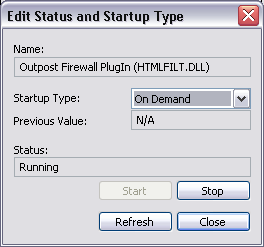Drivers
This tab displays drivers installed on your system. The list includes only drivers with a non-empty binary file name. The kernel drivers are sometimes used by various keylogger/spyware software to record system events.
Warning: if, during a software installation, the alert dialog appears and notes that a new driver is added, THIS DOES NOT MEAN THAT THE DRIVER IS A SPYWARE DRIVER and not a legitimate hardware driver. Some software may require a certain hardware driver that is not installed yet, so the driver is installed during the software installation.
Please be very careful with drivers. Do not change anything unless you're 100% sure what you're doing.
What's A Driver?
A device driver is a component that Windows uses to provide I/O services for and interact with an underlying device, such as a modem or network adapter. Rather than access the device directly, Windows loads device drivers and calls functions in the drivers to carry out actions on the device. The driver functions contain the device-specific code needed to carry out actions on the device. Device drivers for Windows 2000/XP (NT drivers) are usually library files with .sys filename extensions.
Drivers can also be used to work as a filter between a program and a hardware device. This allows spyware/keylogger programs to record user activity and even change the contents of the data received by a program (e.g. web pages received by Internet Explorer). Note that an NT driver is a subtype of a service also called "driver service".

The Edit Action
The edit action allows you to set the startup type of the driver, stop or start it. Please note that you should use this action only in emergency cases when there's no other way to stop or delete the driver. Sometimes stopping or deleting the driver can lead to a blue screen error appearing and require a system reboot. Please, first try all normal methods to un-install the driver before applying the edit action.

The Delete Action
The delete action (depending on the selected options):
- Stops the driver;
- Deletes (uninstalls) the driver from the service control manager database;
- Deletes the driver file;
You may need to reboot Windows for the action to take effect.
Properties
| Name | The name of the driver (the name of the driver's key in the registry). |
| Display Name | The user-friendly name of the driver. |
| Description | The description of the driver retrieved from the driver file's resources. |
| Type |
The type of the driver:
|
| Dependent Services/Drivers | Names of services/drivers that depend on this service; that is, this service must be running before the dependent services/drivers can run. |
| Startup |
Defines the way the driver is started:
|
| Publisher | The developer (a company or a person) of the driver. |
| Command | The command line parameters the driver was started with. |
| File | A full path to the driver file. |
| File Version | File version information. The information is retrieved from the file resources. Also includes product version information if it differs from the file version. |
| File Size | File size in bytes. |
| File CRC32 | Cyclic Redundancy Checksum (Check) of the file. |
| File MD5 | Message Digest 5 of the file. |
| File Creation Date | The date the file was created. |
| System |
Indicates whether the item is a system item, i.e. originally shipped with Windows. WARNING: Browser Sentinel does not always correctly differentiate third-party items and system items, use this property with care! |
| Safe | Indicates whether the item in a safe or in a blocked list. Yes - item is in a safe list. No - item is in a blocked list. N/A - items is not in a safe nor in a blocked list. |
| Status |
The current status of the driver:
|
More Information
Device drivers
What Is a Device Driver?
Introduction to Windows Drivers
Device Drivers
Troubleshoot Device Driver Problems